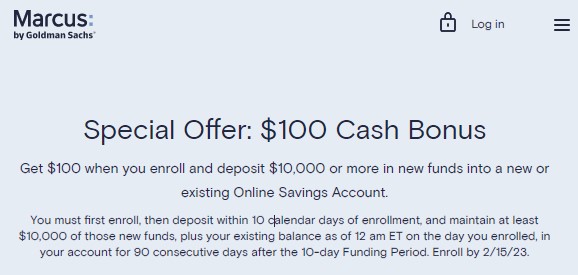Marcus by Goldman Sachs is an online savings account offered by Goldman Sachs Bank USA.
You're probably familiar with the Goldman Sachs, the investment bank, and Goldman Sachs Bank USA is their more “typical” banking services. They are FDIC insured (FDIC #33124) like every other bank listed on this blog.
From time to time, they offer bonuses and for a limited time, they have one available.
The last time they had a bonus offer, it was also around this time of year, with these similar terms, and they only offered it once. So if you're interested, jump on it because it probably won't be back for the rest of the year (unless they change their minds on how they're going to run it).

Marcus by Goldman Sachs – $100 Offer [EXPIRED]
🔃UPDATE February 2023: Sadly, this offer has now expired.
Marcus will give both new and existing customers a $100 bonus for depositing $10,000 or more into a new or existing Online Savings Account.
You just need to enroll in the offer and then, within 10 days, make the deposit. Then maintain that $10,000 amount (plus existing balance if you are using an existing account) for 90 days to get the $100.
This is an offer they tend to offer just once a year, around this time. Last year, they offered this exact same promotion with an expiration of 2/16/2022.
This year, the offer expires 2/15/2023.
How does this bonus compare?
If you are an existing Marcus customer with $10,000 sitting somewhere else, it's a great deal because you get basically 1% for 90 days – or an effective return of about 4% a year. Not bad for very little work but you can get something similar from a high yield savings account.
If you aren't an existing customer and you've always wanted a Marcus account (and you have $10k), might as well get an extra $100 for your trouble.
If you're looking at this non-direct deposit bonus and wondering if your $10,000 might be better placed elsewhere, the answer is maybe. If you have $15,000 then you get more cash by going with the Citi Priority or Discover offer.
U.S. Bank – up to $450
Earn up to $450 when you open a new U.S. Bank Smartly® Checking account and complete qualifying activities. Subject to certain terms and limitations. Offer valid through April 17, 2025. Member FDIC.
Offer may not be available if you live outside of the U.S. Bank footprint or are not an existing client of U.S. Bank or State Farm.
Barclays – $200
Barclays Bank will give you a $200 if you open a new savings account and deposit $25,000 within 30 days of opening the account and maintain at least $25,000 in that account for 120 days. The savings account also pays a competitive interest rate of up to 4.50% APY while you wait.
BMO Checking – $350
BMO is offering a $350 bonus* when you open a BMO Checking account and have $4,000 in direct deposits within 90 days of opening. It is a very straightforward offer that is available nationwide.
*Conditions apply
Bank of America – $300 Bonus Offer
Bank of America offers a $300 Bonus Offer cash bonus if you open a new account and Set up and receive Qualifying Direct Deposits* totaling $2,000 or more into that new eligible account within 90 days of account opening. Bank of America Advantage SafeBalance Banking® for Family Banking accounts are not eligible for this offer. It has a monthly fee that is easy to have waived.
Chase Total Checking® – $300
Chase Bank will give you $300 when you open a Total Checking account and set up and receive direct deposits totaling $500 or more within 90 days. There is a $12 monthly fee that is waivable with a monthly direct deposit of just $500, so no gotchas on this deal!



